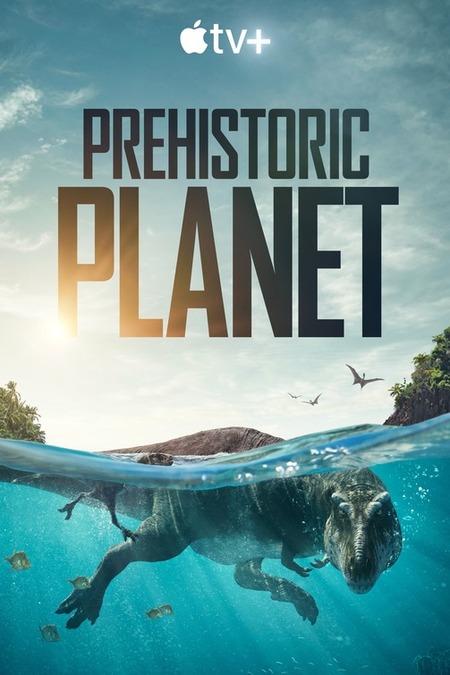There is no denying that we have a fascination with prehistoric life.
And really, why wouldn’t we? The creatures of long, LONG ago capture our imaginations because of their considerable removal from our own modern world, their otherworldliness and difference which stands in marked contrast to anything we have in our lived reality today.
It’s why dinosaurs and the others creatures of the prehistoric realms consume our attention completely and why shows like the BBC’s Prehistoric Planet, streaming on Apple TV+, are almost guaranteed audience magnets – we want to immerse ourselves in times and places not our own, and save for aliens landing on earth, going to back to the Jurassic or the Cretaceous is one of the most spectacular ways to do it.
What sets this five-part series apart, quite apart from its stunning live-action CGI which brings dinosaurs, marine reptiles and the pterosaurs alive in scientifically accurate ways we have never seen before – velociraptors with feathers? Absolutely correct, something that Jurassic World has yet to accede to – is that retains this heady sense of otherworldliness and difference while bringing the prehistoric world very much into the long line of life on earth which is, of course, exactly where it sits.
It is now well established, though conjecture remains, that birds for instance are the revolutionary descendants of dinosaurs and that ancient “living fossil” fish such as the Coelacanth have survived to the present day but so extraordinary have dinosaurs and their fellow prehistoric creatures felt, and to be fair, how they have often been presented, that it’s hard not to feel like they have occupied some other weird realm of existence or alternate Earth.
But of course they haven’t; they are firmly, thrillingly part of the long story of life on earth, and Prehistoric Planet, narrated by the authoritatively dulcet tones of the king of nature documentaries, David Attenborough, whose sense of meditative wonder never ceases to make you feel as if each natural moment you’re witnessing is the most incredible thing ever (which it is), knits the ancient world into the modern simply by presenting it like any other nature documentary.
That might sound like an obvious thing to do given dinosaurs et al are very much a part of a long line of natural life, but as you subsume yourself in the visual and informational wonder of Prehistoric Planet it feels daringly new or revolutionary.
Finally we have a documentary series that talks as if dinosaurs, pterosaurs and marine reptiles are here on earth now, and while we can be thankful they are not if Jurassic World: Dominion is any indication of the havoc they would wreak, it gives these ancient creatures an immediacy and presence they haven’t had before, even in groundbreaking shows like Walking With Dinosaurs which attempted much the same thing, and brilliantly though not as successfully so.
Of course, with the rapid advance of technology, the events presented in Prehistoric Planet, which covers Coasts, Deserts, Freshwater, Ice Worlds and Forests in awe-inspiring detail, bring late Cretaceous creatures alive in a way they have never been before, giving us insight into the way they hunted for prey, raised their young, mated and sought food and shelter.
We see the cycle of life, for instance, in the deserts where giant duck-billed Hadrosaurs and small, feathery Mononykus struggle side-by-side through the good and the bad times when water is abundant and plants blooms until they do not.
We also bear witness to the menacing carnivorous Tarbosaurus which hunts these creatures, seeking, as they do, to survive in a realm that seems implacaably opposed to life.
They are but a sample of the prehistoric animals who leap from the display stands and glass cabinets to be as alive as anything living around us now, so that we see prehistoric staples such as Ankylosaurus and Triceratops alongside lesser-known but no less impressive denizens of the land, air and sea such as Mososaurus, Tuarangisaurus, Kaikaifilu, Nanuqsaurus and Olorotitan all brilliantly, captivatingly and naturalistically alive.
This is no accident, of course.
As Live Science notes the series has had a long gestation, drawing on considerable scientific expertise to reflect the latest discoveries and knowledge about prehistoric life.
“Paleontologist and consultant Steve Brusatte said the series had been in active development for “a decade” prior to its release, though we didn’t learn about its existence until May 8, 2019.
Helping with up-to-date paleontological research were paleozoologist Darren Naish, serving as the lead consultant for the depictions of prehistoric life. He was joined by scientists Brusatte, Alexander Farnsworth, Kiersten Formoso, Michael Habib, Scott Hartman, John R. Hutchinson, Luke Muscutt, Peter Skelton, Robert Spicer, Paul Valdes and Mark Witton.
The result of that impressive brain trust is a series that feels like it sprang fully-formed from decade-upon-decade of paleontological investigation, burnished by cutting-edge special effects that seamlessly blend CGI animals with live action environments so that every shadow, scuffed piece of ground and disturbed body of water is captured in scintillating detail.
It’s a wondrously immersive experience, akin to being dumped into the late Cretaceous, well ahead of that godawful asteroid that ended the rein of the dinosaurs, and you are left spellbound and absorbed to the very end, each moment a window to a long vanished world which thanks to scientific brilliance, some dazzling effects and the superlative narration of David Attenborough, is quite simply the best thing to happen to the prehistoric world in quite some time.
OOOO
